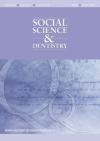Social Science and Dentistry

- Cover Date:
- June 2012
- Print ISSN:
- 2040-4263
- Vol:
- 2
- Issue:
- 1
Dental anxiety and the oral health of the population
The Adult Dental Health Survey is carried out every ten years in the UK (Scotland excepted) to assess the health of the adult population. I am going to present the main findings from the 2009 ADHS, first looking at general dental health and in particular dental anxiety and the impact on dental health. The sample size for the survey was 13,400 households, including: 1,150 in each English Strategic Health Authority and Wales, and 750 households in Northern Ireland. A total of 11,380 individuals were interviewed, and 6,469 dentate adults were clinical examined, making this the largest ever epidemiological survey of adult dental health in the United Kingdom. Scotland did not take part in this survey so we do not have data for the whole UK. However oral health has continued to improve for the last 40 years, particular in the younger age groups. There is some variation between countries but the trends are similar, i.e. general improvements. However those who have dental disease need very complex care particular the older generation (O’Sullivan et al., 2011). In 2009, 94% of people in England, Wales and Northern Ireland were dentate (i.e had at least one remaining natural tooth). The percentage with no natural teeth has fallen by 22% from 28% of the population in 1978 to just 6% in 2009. The vast majority (60%) of dentate adults had 27-32 teeth; around 17.9 sound and untreated teeth but this varied with age. Only 17% had healthy gums and only 10% had excellent oral health (decay and gum disease). A third of adults had decay on dental inspection and this varied between social class, with routine manual occupations having more decay than professional occupational. Eighty four percent of dentate adults had at least one filled tooth, and for those with a filling the mean number of teeth affected was 7.2 with an average of 2.1 surfaces affected per restored tooth. Adults aged under 45 years were less likely to have any fillings, and those who did had relatively low numbers of filled teeth. By contrast, 97% of dentate adults aged 45 to 54 had a filled tooth and they had 9.1 teeth affected on average. In 2009, 37% of dentate adults had artificial crowns. There was significant variation with age; only 5% of the 16-24-yearolds had crowns compared to between 55-59% of those aged 45-74. For those with crowns, on average there were three per person, amounting to an estimated 47.6 million crowns across England, Wales and Northern Ireland. The majority of dentate adults (85%) had a tooth affected by restoration (Fuller et al., 2011). Among people with at least one restoration, 9% had some secondary decay (decay which is immediately adjacent to previously placed fillings or fissure sealants) in their mouth, and 26% had either secondary decay or an unsound restoration for some other reason, in other words the likely need for some sort of intervention. Not surprisingly, failing restorations were most common in the groups with the most restored teeth, so there was a significant age related risk of having a restored tooth needing some attention. The average number of restored but otherwise sound teeth has fallen from 8.1 teeth in 1978 to 6.7 in 2009. In 2009, nearly one in five adults wore removable dentures of some description (partial or complete). This included almost all of the 6% who were edentate, as well as 13% who relied on a combination of dentures and natural teeth. Over a third of people (37%) had none of the eight indicators of complexity and a further 27% had only one. Three or more indicators would represent a fair degree of complexity in terms of ongoing management of multiple conditions, and this threshold was reached by 19% of the population (Steele et al., 2011).
Key Words: Dental anxiety, Adult Dental Health Survey
- Article Price
- £15.00
- Institution Article Price
- £
- Page Start
- 25
- Page End
- 28
- Authors
- Kirsty Hill
Articles from this issue
- Title
- Pg. Start
- Pg. End
- Perceptions of Australian Mothers on Infant Teething: A Pilot Investigation Using a Mixed Methods Approach
- 3
- 11
- AFTER and beyond: cancer recurrence fears and a test of an intervention in oral and oropharyngeal patients
- 29
- 38
